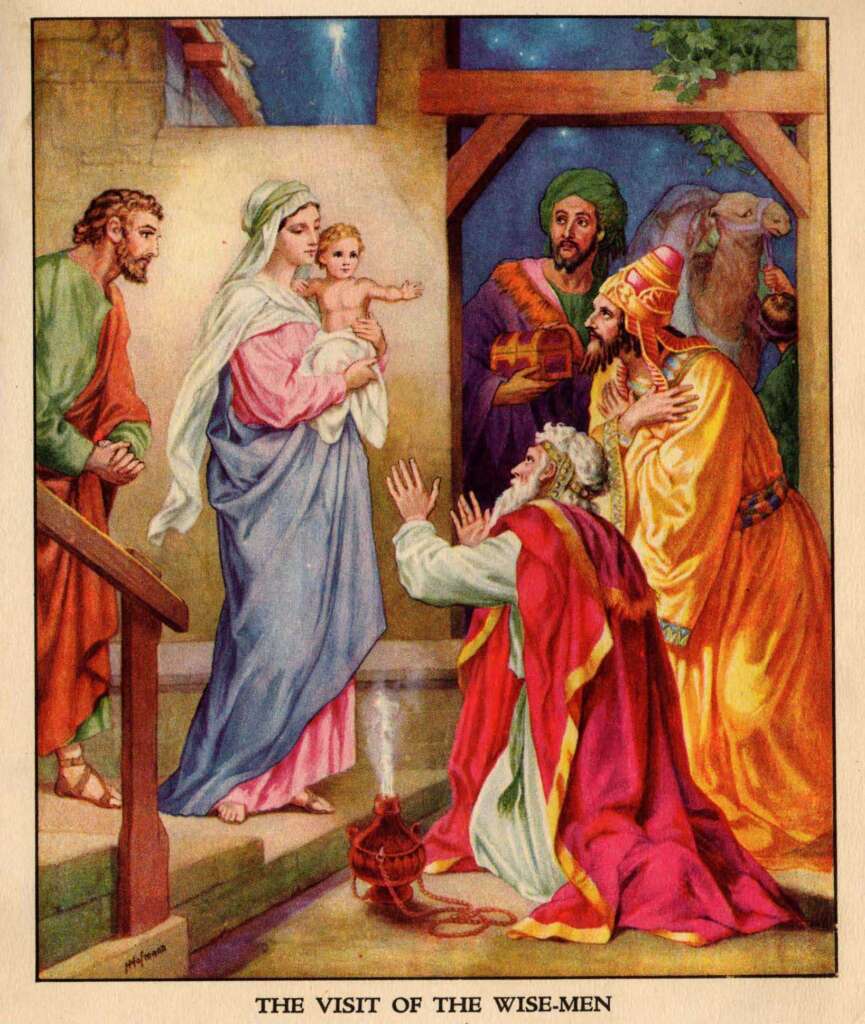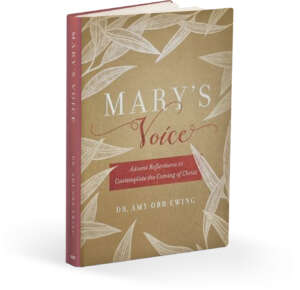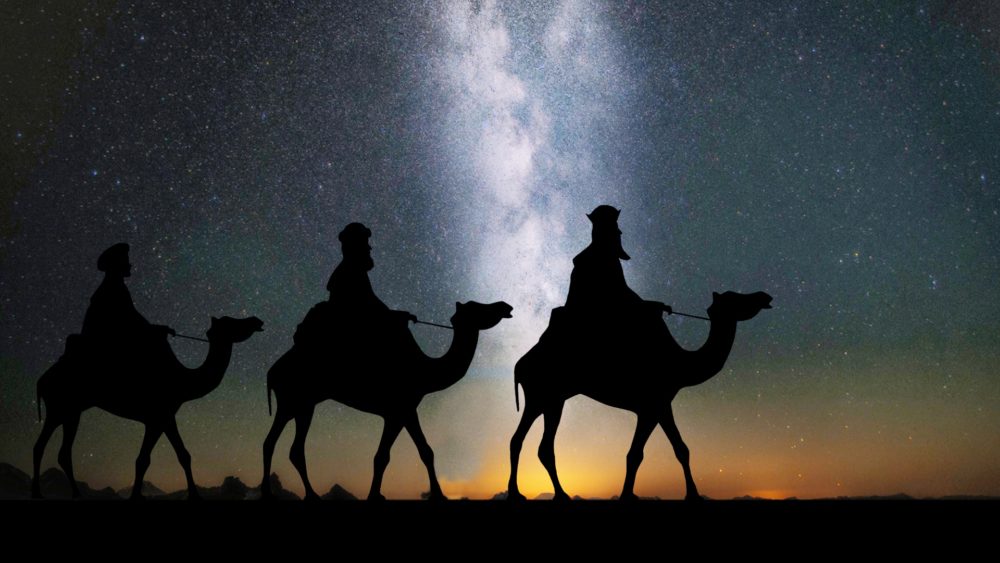The following reflection is an excerpt from Amy Orr-Ewing’s new book, Mary’s Voice – Advent Reflections to Contemplate the Coming of Christ.
December 24
After Jesus was born in Bethlehem in Judea, during the time of King Herod, Magi from the east came to Jerusalem and asked, “Where is the one who has been born king of the Jews? We saw his star when it rose and have come to worship him.” (Matthew 2:1-2)
The Magi were known figures of historical significance at the time. They are mentioned in other contemporary texts. They came from Mesopotamia. The Magi were a known part of the ruling elite of the Parthians at the time Matthew is describing – they had religious, astrological and philosophical learning and they were also political figures. Some of the Magi were Parthian diplomats who were interested in foreign leadership and governance. The Greeks and Romans knew the Magi as part of the ancient world elite. And it is a group of Magi who arrive to pay respects to Jesus Christ after his birth. Mary had experienced confirmation of the truth of the incarnation in the birth of Jesus from the Angel Gabriel, Elizabeth, a group of shepherds, Simeon, Anna, and now Magi.
First of all, they go to the court of Herod, having logically deduced that this was the most likely place for a king of the Jews to be born. A group of Parthian Magi turning up to visit Herod would have been politically and religiously significant. Magi were famous in the ancient world for getting their astrology right. And the historian Josephus tells us that Herod was interested in signs and omens. Now this group arrives and tells him a new King of the Jews had been born. They would have had enormous credibility with Herod. These men are learned stargazers, well used to deducing philosophy from the night sky, and based on what they see, they arrive in Jerusalem looking for a child who has been born King of the Jews. They have seen evidence, and based on that they decide to seek out this child to worship him.
This is as astonishing in that culture as in ours today – for men with great influence and power to kneel and worship a baby.
The psalmist tells us that “the heavens declare the glory of God” (Psalm 19:1). It is not unusual for people to find their way to Christian faith through studying cosmology and astronomy. Alister McGrath studied the stars as a teenager, and this awakened in him the possibility of God. He writes:
“Back in the 1960s, we were told that religion was fading away, to be replaced by a secular world. For some of us that sounded like a great thing. I was an atheist back in the late 1960s, and remember looking forward to the demise of religion with a certain grim pleasure. I had grown up in Northern Ireland, and had known religious tension and violence at first hand …. The future was bright and godless … I started out as an atheist, who went on to become a Christian. I had originally intended to spend my life in scientific research, but found that my discovery of Christianity led me to study its history and ideas in greater depth. I gained my doctorate in molecular biophysics while working in the Oxford laboratories of Sir George Radda, but then gave up active scientific research to study theology.”1
But the Magi’s belief, deduced from the star they have seen, is more specific than a belief in God. There have been many explanations as to what this star might be. Some have suggested that the Bethlehem star was a supernova, a comet, a massing of planets, or the conjunction of Jupiter and Venus on June 17, 2 BC. It could be that any of these explanations are the right one, or perhaps the star was a supernatural phenomenon placed there by God, since the star Matthew describes appears to be dynamic; after all it “went ahead of” and “stood over where the child was.”

‘The Adoration of the Magi’ or ‘The Visit of the Wise-men’ by Heinrich Hofmann (circa 1887) Wikimedia Commons1 License
The star somehow alerted the Magi to Christ’s arrival, inspiring them to leave everything, and travel east to Jerusalem. This shows us something very significant about Jesus. Although Jesus was born in relative poverty and humility to an unmarried mother who was part of an oppressed people living under Roman occupation, these eminent, powerful, scholarly men have discerned from the evidence that one who is worthy of their worship has been born.
Light observed in the heavens has attracted them to worship the one they believe has been born a King of the Jews, and following the constellation or star, they find Jesus with Mary. And they worship him. This is as astonishing in that culture as in ours today – for men with great influence and power to kneel and worship a baby.
The Magi, with all of their philosophy and scientific learning, recognise that this child is worthy of their worship. And they offer him gifts. Three are mentioned in particular. Gold for kingship. Frankincense, which was key to the role of priest, signifying holiness. And myrrh, a spice used in burial. An unusual gift for a baby, but Jesus is no ordinary baby; his death will be sacrificial, and the myrrh points us to the meaning of his death. They provide us with a beautiful and rare image of power. They are prepared to humble themselves and use their power to kneel in worship of the true King.
With the Magi can we discern these signs?
But Mary’s world is also a world where power is corrupted and corrupting. Herod is a megalomaniac ruler, a deceptive and dangerous character with an active religious veneer. This powerful man even pretends to want to worship the newborn King of the Jews, but he has no such intention. He hopes to crush any threat to his own position. Herod is a consummate and brutal power abuser.
When Herod realises that the Magi aren’t coming back to see him after they have found the child, and that they aren’t going to show him the way to the baby born to be King of the Jews, he decrees that all the boys under two years of age in the Bethlehem area be slaughtered. This is the kind of man Herod was – perfectly capable of murdering young children, one of whom was a potential threat to his kingship. Ancient sources tell us that on his deathbed, Herod realised that the Jews would celebrate, not mourn, his death. To ensure that the Jews mourn when he died, Herod commanded various Jewish nobles be murdered – so that as their families mourned there would be a period of mourning after his own death.
The gospels do not flinch from describing reality even as we think about Jesus coming as the light of the world – darkness is real. What a contrast with the light of the star, and the joy of the Magi who humble themselves before the baby of Bethlehem!
At the turning of this year, in Advent, we may feel surrounded by darkness, anxiety, lament, and fear – but there is hope. With the Magi can we discern these signs? The signs are there for each of us to see too. The star or constellation signifying the birth of the King of the Jews in Bethlehem, the prophecies in the Old Testament about Jesus’ life and birth. The Magi recognise, when they find the mother and her child, that Mary’s child is worthy of their worship. Isaiah 60 speaks of kings coming to the brightness of the Lord’s dawn and light, and this is the invitation to us to do the same. In this dark world why not invite the light of the world to shine upon us today?
Prayer
Heavenly Father,
whose children suffered at the hands of Herod,
though they had done no wrong:
by the suffering of your Son
and by the innocence of our lives
frustrate all evil designs
and establish your reign of justice and peace;
through Jesus Christ your Son our Lord,
who is alive and reigns with you
in the unity of the Holy Spirit,
one God, now and for ever. Amen.
(The Church of England Book of Common Prayer)
 The hardback version of Amy Orr-Ewing’s book Mary’s Voice – Advent Reflections to Contemplate the Coming of Christ will be available in Australia next year. In the meantime, you can purchase the audio or Kindle version by visiting Amy’s website here.
The hardback version of Amy Orr-Ewing’s book Mary’s Voice – Advent Reflections to Contemplate the Coming of Christ will be available in Australia next year. In the meantime, you can purchase the audio or Kindle version by visiting Amy’s website here.
Email This Story
Why not send this to a friend?


